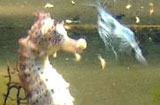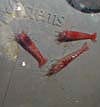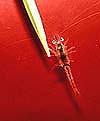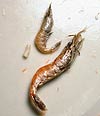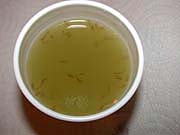The Curly-Cue Anemone is also commonly known as the Trumpet Anemone or Rock Anemone. They are found in the Mediterranean and Eastern Atlantic Ocean, in calm shallow areas where they generally live solitary lives. The body is opaque amber with yellowish-white spots, while the tentacles vary from brown to brown/violet as they extend away from the body, and are translucent with spots. The Curly-Cue Anemone has long flowing tentacles, which are usually wrapped with light corkscrew markings. They Curly-Cue Anemone is a good addition for reef tanks where they can find a calm area along the live rock to situate themselves. They will usually stay in one place for long periods of time and do not do much moving. When disturbed the Curly-Cue will rapidly retract its tentacles becoming a very small ball. Be sure to have enough available space for the Curly-Cue Anemone to find a suitable spot that is not too close to any other coral or invertebrate inhabitants. The Curly-Cue Anemone prefers to live singularly in calm shallow water. In the aquarium environment they should be provided with protected areas of the floor where they can live partially hidden in the live rock or aquascaping. They prefer protected crevices or overhangs without direct waterflow. Also be sure that the Curly-Cue Anemone will be able to find a suitable location that is also away from other Anemones or Corals as they will need space between themselves and other species. The Curly-Cue Anemone is a carnivore and will eat most meaty foods including: fish, mussels, crustaceans and shrimp. They should be given high quality frozen meaty preparations or fresh marine shrimp, chopped fish or mussel. The Curly-Cue Anemone will also require supplements to do well in the aquarium environment, including Iodine and trace elements.ods such as frozen brine or mysis shrimp, mussels or pieces of fish. This species will also eat any foods that get by the fish in the aquarium, making them good for keeping the aquarium free of excess and decaying food stuffs. | Quick Facts :: Curly-Cue Anemone | ||||||||||
| Care Level: | Moderate | ||||||||||
| Temperament: | Aggressive | ||||||||||
| Maximum Size: | 10" | ||||||||||
| Diet: | Carnivore | ||||||||||
| Aquarium Level: | All | ||||||||||
| Minimum Tank Size: | 55 Gallons | ||||||||||
| Reef Compatible: | Yes | ||||||||||
| Water Conditions: | 72-78� F, dKH 8-12, sg 1.020-1.025, pH 8.1-8.4 | ||||||||||
| Supplements: | Iodine, Trace elements | ||||||||||
| Coloration: | Brown, Tan, Yellow, Orange | ||||||||||
| Origin: | Easteran Atlantic, Mediterranean | ||||||||||
| Family: | Aiptasiidae | ||||||||||
| Species: | Anemones | ||||||||||
Search This Blog
Beautiful Reef

Thursday, March 20, 2014
ANEMONE OF THE WEEK - Curly-Cue Anemone (Bartholomea annulata)
Click here to Buy your own Curlique Anemone!
Click here to Buy your own Curlique Anemone!
Feeding Your Seahorses
Seahorse Foods and Feeding A brief overview of what and how to feed your seahorses. SEAHORSE.ORG |
|||||||||||||||||||||||||||||||||||||||||||||||||||||||||||
It is ideal to offer seahorses a variety of foods - in the wild, they would not eat only one food source, so in captivity they shouldn't be expected to. Varying their diet allows for a more complete nutritional profile, as well as providing mental stimulation which they often lack by only feeding one food type. When feeding, whether live or frozen foods, its best to offer food that originated from a marine environment. Marine animals are rich in Highly Unsaturated Fatty Acids (HUFAs) that freshwater organisms lack or have in the wrong concentrations. The HUFAs are produced by phytoplankton, base of the marine food chain so all marine organisms are dependant on them in some way. Freshwater animals fed can be fed to marine animals, but they need to be enriched with different products containing the necessary fatty acids, such as Selco, or Ocean Rider Vibrance. The exception to this rule is Brine shrimp, while they are technical marine, coming from a saline environment, their ecosystem is much different than the ocean, and therefore do not have the HUFA's of other marine animals. Live Food Some believe that live foods are the best foods available for seahorses. It was only a few years ago that the only foods ever offered to seahorses was live food. The availability of captive bred seahorses and new techniques for training seahorses has changed that, although much live food is still offered as occasional treats or for Wild seahorses that can't be trained on frozen food. While there are many types available to the hobbyist, it can be difficult to obtain from local fish stores. Culturing live food in quantities large enough to feed seahorses provide a significant challenge to seahorse keepers. Most cultures require large amount of space and are labor intensive. Others breed to slow if at all. For most hobbyists, live food has to be purchased over the internet, or if they're lucky enough to have this option, collected from local waters. *IMPORTANT NOTE* Some wild caught seahorses refuse to be trained on to frozen foods. Others learn, but stop for no apparent reason. Anyone attempting to keep wild caught seahorses should plan to dedicate themselves to continuously providing live food should such circumstances arise. There are cases were no amount of diligence or experience will result in wild seahorses eating frozen foods. For that reason, if you are not prepared to offer live foods for the natural life span of your seahorse, which could be up to 7 years, I strongly suggest you do not consider keeping wild caught seahorses.
Most captive bred seahorses readily accept the appropriate frozen foods. Some wild caught seahorses can be trained as well to eat frozen. Below are some of the frozen foods that can be fed to seahorses.
Enriching Enriching foods is done to complete the nutritional foods offer to seahorses. In many cases, the foods offered, while good, lack certain components or do not have the right proportions of the correct components. For example, PE mysis is a great food source. However, the HUFA EPA (Eicosapentaenoic acid ) to DHA (Dososahexaenoic acid) ratio is too high. Too much EPA interferes with the bodies use of other necessary fatty acids, while high DHA to EPA increases the growth rate in fish. And many freshwater food sources do not contain any fatty acids, which is why enriching is so important. The number of enriching products ranges in the thousands, and are specific to what your intended results are; such as general HUFA increase, DHA increase, enriching for color enhancement, additional protein, etc . . . as well as the existing profile of the food you are trying to enrich. Discussing the specific products and uses is beyond the scope of this article. However, some commonly use enrichment products are: SELCO - increasing HUFAs Spirulina - Protein, Vitamins, low in HUFAS Naturose - astaxanthin powder for color enhancement. Phytoplankton and Phytoplankton pastes - Increasing HUFA, pigmentation Vibrance - Astaxanthin and HUFAs? SpectraVital - Rumored to be the same as Vibrance I encourage each person to tailor their enrichment needs on the foods that they offer. Researching enrichment products used in commercial aquaculture is likely to give all the answers to what product is best for you. How to Enrich: There are several ways one can enrich foods. I'm only covering the ways that work best for me, but don't be surprised to find many people suggesting many different ways. Small Frozen Food. Take a chunk of mysis and place in a plastic dixie cup. Add enrichment product. Once thawed, mix up the enrichment product with the mysis and add more if necessary. Leave overnight. The next day, rinse lightly in a regular net. If you use a net with holes too small, the excess of some non-liquid products don't rinse away properly. Feed to your seahorses. Large Frozen Foods. WARNING, PROCEED AT YOUR OWN RISK! SHARP POINTING THINGS AHEAD! I prefer this way of feeding because then I know the products are getting in the food. I use it primarily for frozen ghost shrimp. Get a small gauge need from a vet or farm supply store. Liquefy any dry enrichment product by adding RO water and mixing in a blender. Inject the enrichment product into the food. If its a shrimp, I will usually insert the needle parallel to the body as far as I can, then inject while I am removing the needle, in hopes of producing a pocket where the enrichment goes, kind of like a twinkie.
| |||||||||||||||||||||||||||||||||||||||||||||||||||||||||||
Tuesday, March 18, 2014
Picking a Saltwater Aquarium Set-up
Picking a Saltwater Aquarium Set-up
This article is intended for the newcomer to the saltwater aquarium hobby who is looking to determine where to begin. This article will hopefully help you decide what type of saltwater aquarium set-up is right for you. If you have never kept an aquarium before, it is advised that you perhaps first start off with a small, relatively inexpensive freshwater tank. The average freshwater tank requires less upkeep, requires less expensive equipment to run and is less expensive to maintain. Get used to the idea of balancing water parameters and the kind of maintenance required to keep a thriving aquarium set-up before you dive deep into a saltwater aquarium display.
If you’ve already decided that a saltwater tank is in your future, here are a few possible tank set-ups for you to consider:
- Fish only (FO)
- Fish only, with live rock (FOWLR)
- Reef
- Lagoon
- Biotope
- Species specific
- Nano
Fish only tank (FO)
The saltwater fish only (FO) tank is one of the easiest to set up and maintain and is recommended for newcomers to the hobby. The only dominant livestock you will keep in this tank will be fish—and with that simplicity comes a similarly relaxed husbandry and maintenance needs if you intend to keep the ubiquitous hardy species that are found in most fish stores. Most fish do not require special lighting and just about any filtration method will suffice, provided that the filter is appropriately sized/powered for the bio-load in the tank.Fish only, with live rock (FOWLR)
The fish only with live rock tank is a half-step up in sophistication from the fish only tank. The major difference is the addition of the so-called live rock. Live rock is a natural product sold in many aquarium shops. It is generally a porous rock that provides natural structure/habitat for your fish inhabitants. The addition of live rock to your tank provides a lot of potential benefits: bacteria in the live rock add horsepower to your biological filter, calcium carbonate in the rock acts as a buffer, the rock also generally acts as a home to beneficial invertebrates that help clean up debris and uneaten food particles in the tank. If you can afford to do so, it is recommended that both beginner and advanced aquarium hobbyists add live rock to your tanks. While a Fish only, with live rock (FOWLR) tank is generally more expensive to set-up than a fish only (FO) tank, it is actually easier to maintain because the live rock provides both a literal and figurative buffer that provides some stability to the tank.Reef
A reef aquarium is an attempt to recreate an ecosystem where both vertebrates (generally fish) and invertebrates including corals, clams and crabs coexist to create a symphony of colors, behaviors and species to re-create a small piece of the ocean. In nature, coral reefs are like the rainforests of the sea—where dense aggregations of life all come together in a tightly knit web. In a saltwater reef aquarium, you attempt to recreate a sliver of that web—but take the freedom to add species from all over the world, provided they have similar enough husbandry needs and are compatible with the other intended inhabitants of the tank. The backbone of the reef aquarium is generally built with live rock, upon which coral or clams are mounted and around which flash the bright colors of reef-safe tropical fish. Reef tanks are a beauty to behold, but also require some sophistication (and money) to set-up and maintain. Reef tanks generally have special requirements for lighting, filtration, water-flow, bio-load and nutritional additives/supplements. Care should be taken to ensure that fish and invertebrates are reef safe to prevent unintended ‘snacking’ inside the tank.Reef aquariums are my true passion, and are a total joy to maintain, but be warned that they are a lot of work and require you to invest in some knowledge and patience to maintain effectively.
Lagoon Aquarium
Lagoon aquariums are set-up to re-create the slow moving tidal backwater ecosystems in nature. Instead of having large displays of live rock, coral and other fast-water loving animals, the lagoon aquarium is generally dominated by slow-moving species, sand beds and plant-like macroalgae.Probably the most popular and notably cool lagoon aquarium inhabitant is the seahorse. While maintaining a lagoon aquarium, by its own merit, is not difficult, some lagoon species, like seahorses are notoriously finicky inhabitants and are NOT recommended for the beginner.
Biotope Aquarium
The goal of the biotope aquarium is to recreate, as closely as possible, a specific niche of the ocean, matching inhabitants in the tank as they would exist in nature. This strategy is not unlike the strategy of many of the tanks we see in public aquaria. The biotope may be focused on fish and corals of the Caribbean, Great Barrier Reef, or Indonesian Archipelago for instance. The possible iterations are nearly endless. A biotope aquarium presents an opportunity to test your skills in creating a fun, vibrant and beautiful display, all while keeping an eye on keeping species together the way mother nature intended—a lofty goal—but worth the investment. The specific equipment needs of the biotope aquarium style vary based on the type of biotope being created.Species Specific
A species specific aquarium can be thought of as a sort of sub-group within the fish only aquarium category.
Essentially, all resources of the tank are designed to create a suitable environment for a single, individual species and watch their behaviors and intra-specific interactions. Often, species specific aquariums are developed to attempt to observe the spawning of the target species, a behavior which sometimes gets disrupted and other times is just hard to observe in a larger community display. The equipment needs of a species specific tank are similar to a fish only tank, but generally on a smaller scale.
Nano
The last aquarium style to consider is the nano aquarium. Nano aquaria have gained a freight train worth of momentum over the last several years. Previously, the old adage was that reef tanks should be no smaller than 55-75 gallons in size. The rationale was that smaller aquarium sizes did not provide enough margin for error to be successful over the long run. The lighting, flow and filtration needs of the typical reef inhabitants were thought to be too demanding to maintain in a small volume aquarium (called a nano). While the margin of error hypothesis holds merit—there are also a lot of benefits in keeping the aquarium volume low.For example, nano tanks are actually much more energy efficient. The amount of energy required to keep them running is far less than to keep a larger reef tank running. Because of their size, the coral species in a nano tank are generally much closer to the light source than they would be in a larger tank—therefore a less powerful light is required to create the same coral growth. Bioload is generally lower, so filtration needs are generally lower. It is much easier to create a brisk flow throw a small tank than a larger tank, so circulation pump requirements are lower.
Nano tanks also require a much smaller footprint in your (human) living space, and so generally they provide an advantage to those of us who live with significant others. So while older classic books may suggest that nano aquariums are difficult to maintain, you should consider that they are easier to maintain in many ways—but that almost everything is exaggerated in the nano tank setting. While that’s beneficial from a lighting, filtration and water flow perspective, it can be dangerous if your water quality deteriorates—so maintenance and water changes are very important.
Conclusion
Hopefully this article presents a few things for you to consider along your journey to decide what type of saltwater aquarium to set up at your home or office. As you can see, the possibilities are nearly endless, and there are trade-offs with every decision you make. However, I hope this has provided you with some perspective about the spectrum of options available to you and the relative sophistication required to create and maintain them. I encourage you to continue searching the web for information posted by others who may have varying information or include other aquarium designs. I also welcome your comments and want to hear your experiences with setting up a tank. Post a comment and let me know what you think of this article.If you want to receive helpful saltwater aquarium tips and information like this emailed to your inbox:
This article written by: Al Ulrich
Subscribe to:
Comments (Atom)



